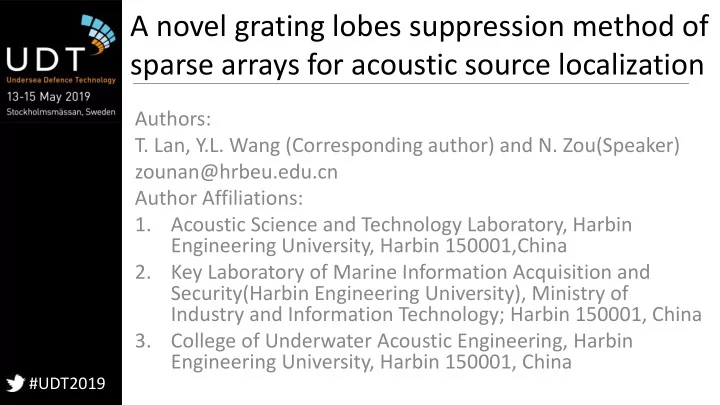

A novel grating lobes suppression method of sparse arrays for acoustic source localization Authors: T. Lan, Y.L. Wang (Corresponding author) and N. Zou(Speaker) zounan@hrbeu.edu.cn Author Affiliations: 1. Acoustic Science and Technology Laboratory, Harbin Engineering University, Harbin 150001,China 2. Key Laboratory of Marine Information Acquisition and Security(Harbin Engineering University), Ministry of Industry and Information Technology; Harbin 150001, China 3. College of Underwater Acoustic Engineering, Harbin Engineering University, Harbin 150001, China #UDT2019
Outline • Problems to be solved • Approach 1) Array Structure 2) Beamforming Method 3) Product & Min Processing 4) Comprehensive Processing • Results and Discussion • Conclusions #UDT2019
Problems to be solved Problem : Existing algorithms : ULA , ; d / 2 Adding sensors to obtain high resolution , high costs ; Optical fiber sensor: d=0.1m , f0 = 7.5kHz; Sparse array is developed, but suffers from azimuth ambiguity caused by the grating lobes . To deal : A new array structure is designed ; Comprehensive processing eliminates the azimuth ambiguity caused by grating lobes. #UDT2019
Approach - Array Structure ULA Co-prime The array structure of optical fiber sensor array #UDT2019
Approach - Beamforming Method (1) For each sub array, the beamforming is carried out utilizing conventional beamforming (CBF). The received signal column vector can be expressed as a vector: X ( ) t A S ( ) t N ( ), t i 1,2,3 i i i A a ( ) a ( ) a ( ) , i 1,2,3 i i 1 0 i 2 0 iN 0 exp( j ) 0 i k 1 exp( j ) 0 i k 2 a ( ) , i 1,2,3, k 1,2,..., N i 0 exp( j ) 0 iM k i #UDT2019
Approach - Beamforming Method (1) The basic orientation information obtained from the three sub- arrays respectively. Spatial Spectrum: H P ( , ) a ( , ) R a ( , ), i 1,2,3 i i ix i p 1 H R X n X n ix i i p n 1 y Output: H ( , ) w ( , ) X i i i Due to the spatial under-sampling, the spatial spectrum obtained by the conventional beamforming scanning of each sub-array is affected by grating lobes, which seriously affect the quality of signal azimuth estimation. #UDT2019
Approach – Product & Min Processing Product Processor: T P , ( , ) y ( , ) conj y ( ( , )), i j i j i j 1,2 Min Processor: P min( P ( , ), P ( , )) min1,2 1 2 [1] Gaussian Source Detection and Spatial Spectral Estimation Using a Coprime #UDT2019 Sensor Array With the Min Processor
Approach - Comprehensive Processing T P , ( , ) y ( , ) conj y ( ( , )), i j 1,2,3 i j i j P min( P ( , ), P ( , ), P ( , )) min1,2,3 1,2 2,3 3,1 P min( P , P ) Com min1,2,3 ula #UDT2019
Results and Discussion Assume that c1=3, c2=4, c3=5 , so sub-array 1,2,3 has 21,16,13 sensors separately . The compared ULA has 3 lines, each line has 60 sensors. Beam Patterns #UDT2019
Results and Discussion Fig.1 Fig.2 #UDT2019 Fig.3
Conclusions • Improve the resolution; • Reduce the complexity of calculation and cost; • Achieve large aperture using a novel coprime sparse sensor arrays; • Suppress grating lobes; • Lower side lobes than Min Processor. #UDT2019
The end THANK YOU ! #UDT2019
Recommend
More recommend